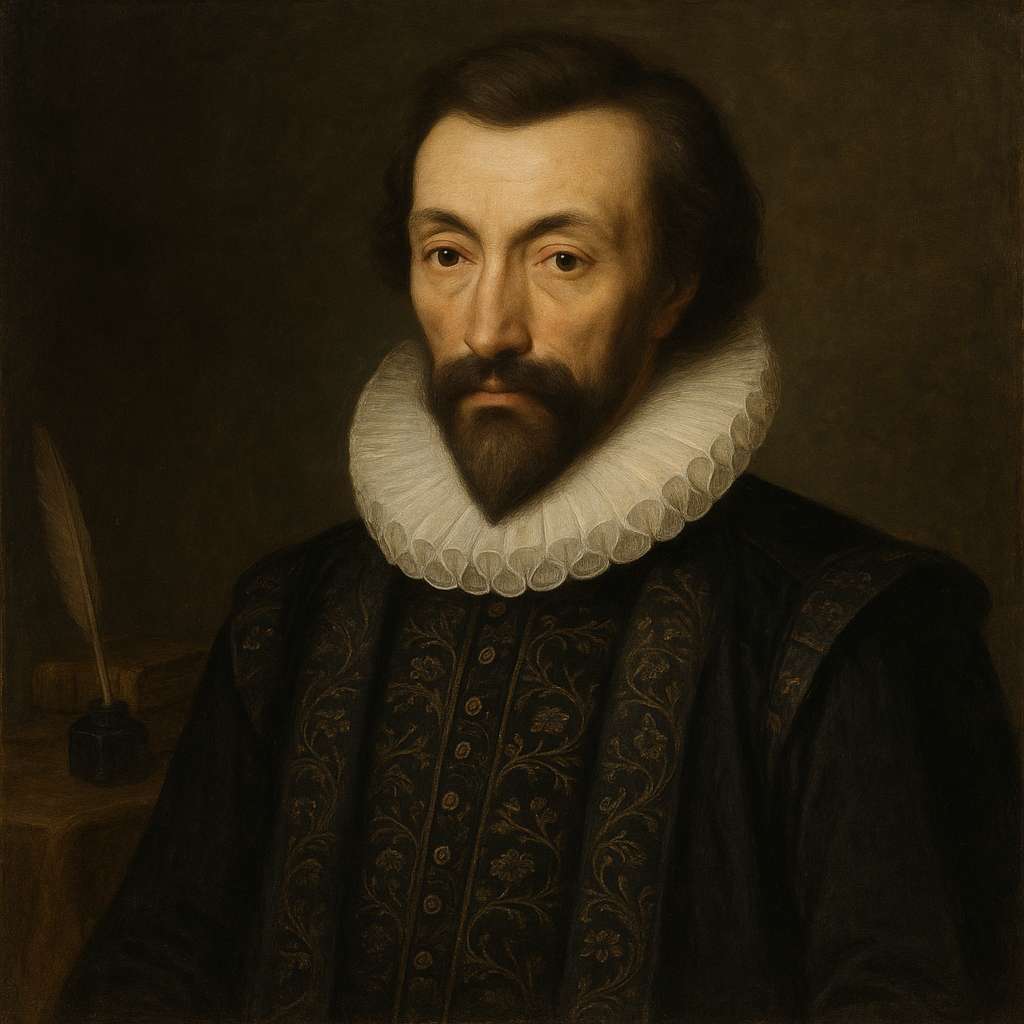The Canonization
John Donne
1572 to 1631

For God's sake hold your tongue, and let me love,
Or chide my palsy, or my gout,
My five gray hairs, or ruined fortune flout,
With wealth your state, your mind with arts improve,
Take you a course, get you a place,
Observe his honor, or his grace,
Or the king's real, or his stampèd face
Contemplate; what you will, approve,
So you will let me love.
Alas, alas, who's injured by my love?
What merchant's ships have my sighs drowned?
Who says my tears have overflowed his ground?
When did my colds a forward spring remove?
When did the heats which my veins fill
Add one more to the plaguy bill?
Soldiers find wars, and lawyers find out still
Litigious men, which quarrels move,
Though she and I do love.
Call us what you will, we are made such by love;
Call her one, me another fly,
We're tapers too, and at our own cost die,
And we in us find the eagle and the dove.
The phoenix riddle hath more wit
By us; we two being one, are it.
So, to one neutral thing both sexes fit.
We die and rise the same, and prove
Mysterious by this love.
We can die by it, if not live by love,
And if unfit for tombs and hearse
Our legend be, it will be fit for verse;
And if no piece of chronicle we prove,
We'll build in sonnets pretty rooms;
As well a well-wrought urn becomes
The greatest ashes, as half-acre tombs,
And by these hymns, all shall approve
Us canonized for Love.
And thus invoke us: "You, whom reverend love
Made one another's hermitage;
You, to whom love was peace, that now is rage;
Who did the whole world's soul contract, and drove
Into the glasses of your eyes
(So made such mirrors, and such spies,
That they did all to you epitomize)
Countries, towns, courts: beg from above
A pattern of your love!"
John Donne's The Canonization
John Donne’s The Canonization is a masterful exploration of love, its transformative power, and its defiance of societal norms. Written in the early 17th century, the poem is a quintessential example of metaphysical poetry, characterized by its intellectual depth, inventive conceits, and blending of the sacred and the profane. This analysis will examine the poem’s historical context, its intricate use of literary devices, its central themes, and its emotional resonance, demonstrating how Donne elevates romantic love to a spiritual and eternal plane.
Historical and Cultural Context
To fully appreciate The Canonization, it is essential to situate it within the historical and cultural milieu of early 17th-century England. Donne wrote during the late Renaissance, a period marked by significant religious, political, and intellectual upheaval. The Protestant Reformation had challenged the authority of the Catholic Church, and England was grappling with its own religious identity under the reigns of Elizabeth I and James I. Donne himself was born into a Catholic family but later converted to Anglicanism, a decision that shaped both his personal life and his poetic voice.
The poem reflects the tension between secular and sacred love, a recurring theme in Donne’s work. At the time, love poetry often oscillated between the idealized Petrarchan tradition and the more carnal, earthly expressions of desire. Donne, however, transcends these conventions by merging the physical and the spiritual, presenting love as a force that is both deeply personal and universally significant. The poem’s title, The Canonization, alludes to the Catholic practice of declaring saints, suggesting that the lovers’ relationship is worthy of veneration and eternal remembrance.
Structure and Form
The Canonization is composed of five nine-line stanzas, each following a consistent rhyme scheme (ABBACCCAA). This structure lends the poem a sense of order and symmetry, mirroring the harmony and unity the speaker attributes to love. The meter is predominantly iambic, with variations that emphasize key phrases and ideas. The poem’s formal rigor contrasts with its passionate content, creating a dynamic interplay between restraint and intensity.
The opening line, “For God’s sake hold your tongue, and let me love,” immediately establishes the speaker’s defiant tone. The imperative “hold your tongue” suggests that the speaker is addressing critics or societal figures who disapprove of his love. This line also introduces the poem’s central conflict: the tension between private passion and public judgment. The speaker’s plea for tolerance is both a defense of his love and a critique of those who would deny its validity.
Literary Devices and Imagery
Donne’s use of literary devices is both intricate and purposeful, enriching the poem’s thematic depth. One of the most striking features of The Canonization is its use of metaphysical conceits—extended metaphors that draw unexpected parallels between seemingly disparate concepts. For example, in the third stanza, the speaker compares himself and his lover to flies, tapers (candles), and the mythical phoenix:
“Call her one, me another fly,
We're tapers too, and at our own cost die,
And we in us find the eagle and the dove.
The phoenix riddle hath more wit
By us; we two being one, are it.”
Here, the lovers are likened to flies and candles, creatures that consume themselves in their pursuit of light and life. This imagery suggests that love is both a destructive and regenerative force, a theme that resonates throughout the poem. The reference to the phoenix, a mythical bird that dies and is reborn from its ashes, further underscores the idea that love transcends mortality. By becoming “one,” the lovers embody the phoenix’s cyclical nature, dying and rising together in a perpetual act of renewal.
The poem also employs paradox to highlight the transformative power of love. In the fourth stanza, the speaker declares:
“We can die by it, if not live by love,
And if unfit for tombs and hearse
Our legend be, it will be fit for verse;
And if no piece of chronicle we prove,
We'll build in sonnets pretty rooms.”
These lines suggest that love grants the lovers a form of immortality, even if they are not remembered in traditional historical records. The act of writing poetry becomes a means of preserving their love, elevating it to the status of art. The metaphor of “building in sonnets pretty rooms” implies that their love will be enshrined in verse, a timeless monument to their passion.
Themes
At its core, The Canonization is a meditation on the nature of love and its ability to defy societal constraints. The poem challenges the notion that love must conform to external standards of propriety or utility. Instead, Donne presents love as a self-sufficient and transcendent force, capable of transforming the mundane into the extraordinary.
One of the poem’s central themes is the idea of love as a form of canonization. By comparing their relationship to the lives of saints, the speaker elevates their love to a spiritual plane. This metaphor is particularly striking given Donne’s religious background and the poem’s historical context. In a society that often viewed romantic love as secondary to duty and piety, Donne’s assertion that love can be a path to sainthood is both radical and subversive.
Another key theme is the tension between the private and the public. The speaker repeatedly contrasts the intimacy of his relationship with the external world’s judgments and demands. In the second stanza, he dismisses the idea that his love has caused harm to others:
“Alas, alas, who's injured by my love?
What merchant's ships have my sighs drowned?
Who says my tears have overflowed his ground?”
These rhetorical questions underscore the speaker’s belief that his love is a personal matter, with no bearing on the wider world. By rejecting the notion that love must serve a public function, the speaker asserts its intrinsic value and autonomy.
Emotional Impact
The Canonization is a deeply emotional poem, despite its intellectual complexity. Donne’s use of vivid imagery and passionate language creates a sense of immediacy and intensity, drawing the reader into the speaker’s world. The poem’s emotional power lies in its ability to convey the depth of the speaker’s feelings while also inviting the reader to reflect on their own experiences of love.
The poem’s closing lines are particularly poignant:
“And thus invoke us: ‘You, whom reverend love
Made one another's hermitage;
You, to whom love was peace, that now is rage;
Who did the whole world's soul contract, and drove
Into the glasses of your eyes
(So made such mirrors, and such spies,
That they did all to you epitomize)
Countries, towns, courts: beg from above
A pattern of your love!’”
Here, the speaker envisions a future in which their love is revered as a model for others. The image of the lovers as “mirrors” and “spies” suggests that their relationship reflects and encapsulates the essence of the world. This vision of love as a universal force is both aspirational and deeply moving, capturing the poem’s emotional and spiritual resonance.
Conclusion
John Donne’s The Canonization is a profound and multifaceted exploration of love’s transformative power. Through its intricate use of metaphysical conceits, paradox, and vivid imagery, the poem challenges societal norms and elevates romantic love to a spiritual plane. By situating the poem within its historical and cultural context, we gain a deeper understanding of its themes and emotional impact. Ultimately, The Canonization is a testament to the enduring power of poetry to capture the complexities of human experience and to connect with readers on a deeply personal level. In celebrating the lovers’ union, Donne invites us to reconsider the nature of love and its place in our lives, reminding us of its capacity to transcend time, mortality, and societal constraints.
This text was generated by AI and is for reference only. Learn more
Want to join the discussion? Reopen or create a unique username to comment. No personal details required!



Comments
No comments yet. Be the first to comment!